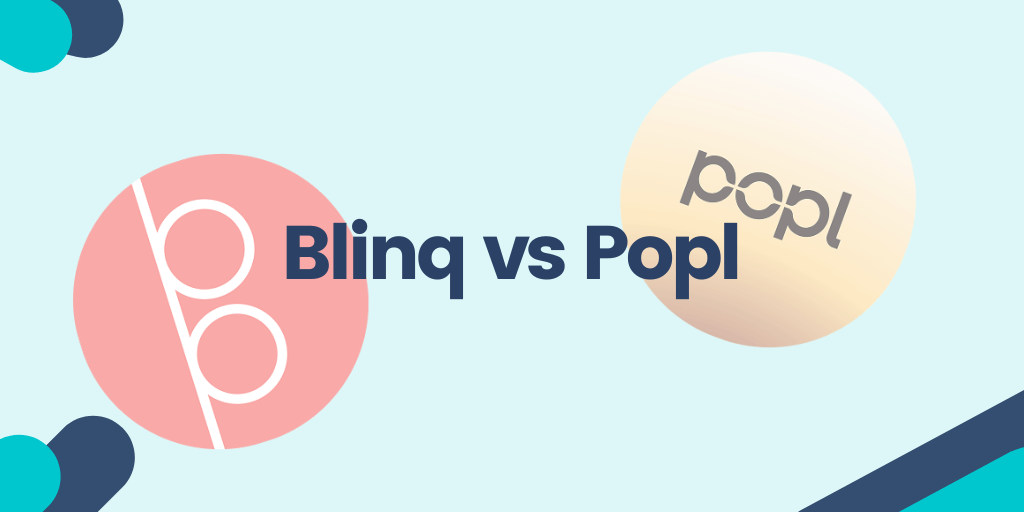Choosing between Blinq vs Popl is less about features and more about fit. The right digital business card platform should naturally align with your workflow, support your business goals, and connect effortlessly with the tools you already use.
In this Popl vs Blinq comparison, we’ll cut through the marketing noise and focus on what matters: usability, integrations, pricing, and long-term value. By the end, you’ll know which platform truly fits your business—and which one doesn’t earn the spot.
Contents:
- Why Compare Blinq and Popl
- Overview of Blinq and Popl
- Key Features and Capabilities
- Blinq vs Popl Pricing
- Integrations and Compatibility
- Customer Support and Reliability
- Pros and Cons
- Blinq vs Popl: Which One is Better in 2025?
- Beyond Blinq and Popl: The Digital Business Card Reinvented by MySignature
- FAQ
Why Compare Blinq and Popl
Choosing a digital business card platform might sound like a relatively small decision—at least in the grand scheme of things—until it starts shaping how every client or prospect perceives your brand. The way your team shares contact details, manages follow-ups, and organizes connections directly impacts professionalism and efficiency.
Among today’s digital business card platforms, Blinq and Popl stand out as industry leaders. Both help businesses look sharp and move fast—but in very different ways.
Here’s why comparing Blinq vs Popl matters:
- Different business needs: Small teams want speed and simplicity; enterprises need CRM integration, admin controls, and scalability.
- Brand consistency: Each platform handles customization and design governance differently—crucial for maintaining a unified brand image.
- Team management: Efficient admin tools save hours in setup and onboarding.
- Integrations: Smooth CRM, email, and HR directory connections turn a platform into part of your workflow, not another task.
- Pricing: Understanding true long-term costs prevents surprises as your team grows.
Taking time to compare options helps you avoid hidden costs, mismatched features, and platforms that look good in demos but fall short in practice. It’s the difference between a digital business card system that simply works and one that truly supports your business.
Overview of Blinq and Popl
Before exploring features, pricing, and performance, it’s worth understanding what sets Blinq and Popl apart at their core. Both lead the business card platforms in 2025 landscape but come from distinct philosophies. Blinq was built to make professional connection effortless and beautifully designed, while Popl emerged to transform in-person networking through data, automation, and measurable results.
Recognized on G2 as category leaders, they define what the best digital business card experience looks like today—one focused on refinement, the other on performance.
What is Blinq
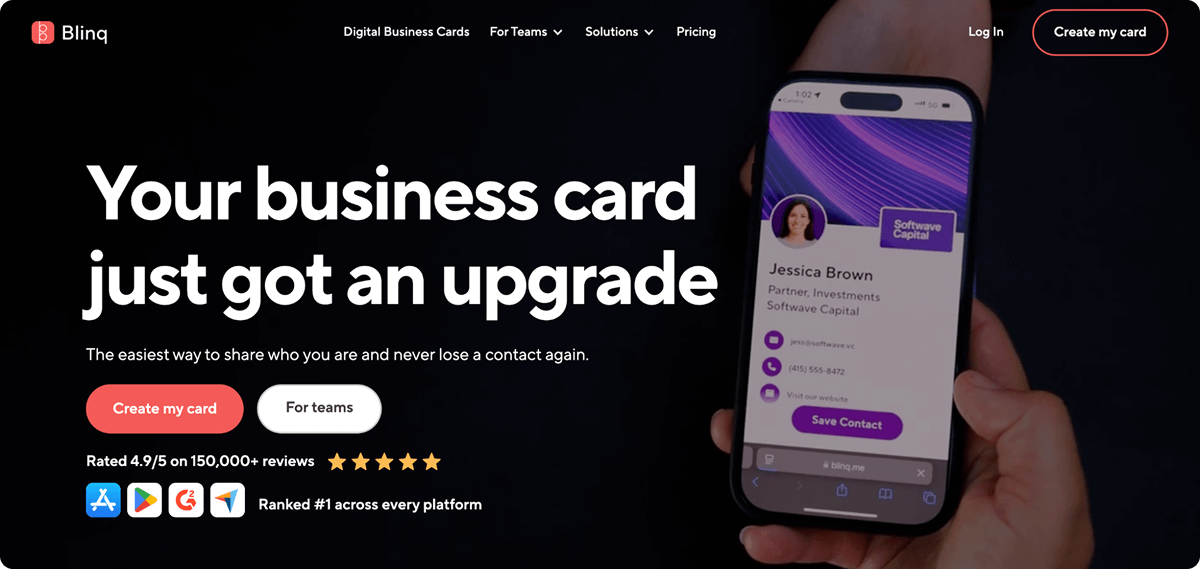
Blinq has established itself as the quiet industry leader among teams that value polish and reliability. Used by more than three million professionals across 500,000 businesses, and rated 4.9/5 on Capterra and 4.8/5 on G2, it’s often cited as one of the best digital business card platforms available in 2025.
The company’s philosophy centers on simplicity and consistency. It was designed around the idea that strong professional relationships come from effortless exchanges. Instead of layering on unnecessary features, Blinq focuses on speed, brand alignment, and a smooth user experience. Whether contacts are shared via QR code at an in-person event or synced through robust integrations with CRM systems, every interaction feels deliberate and friction-free.
Blinq now operates as more than a digital card tool—it’s a connection management platform. Beyond contact sharing, it offers branded email signatures, virtual meeting backgrounds, and a central admin dashboard that keeps company branding uniform across teams.
Operating in 189 countries and backed by leading investors, Blinq continues to grow around a clear mission: simplifying professional connection and making every interaction seamless.
What is Popl
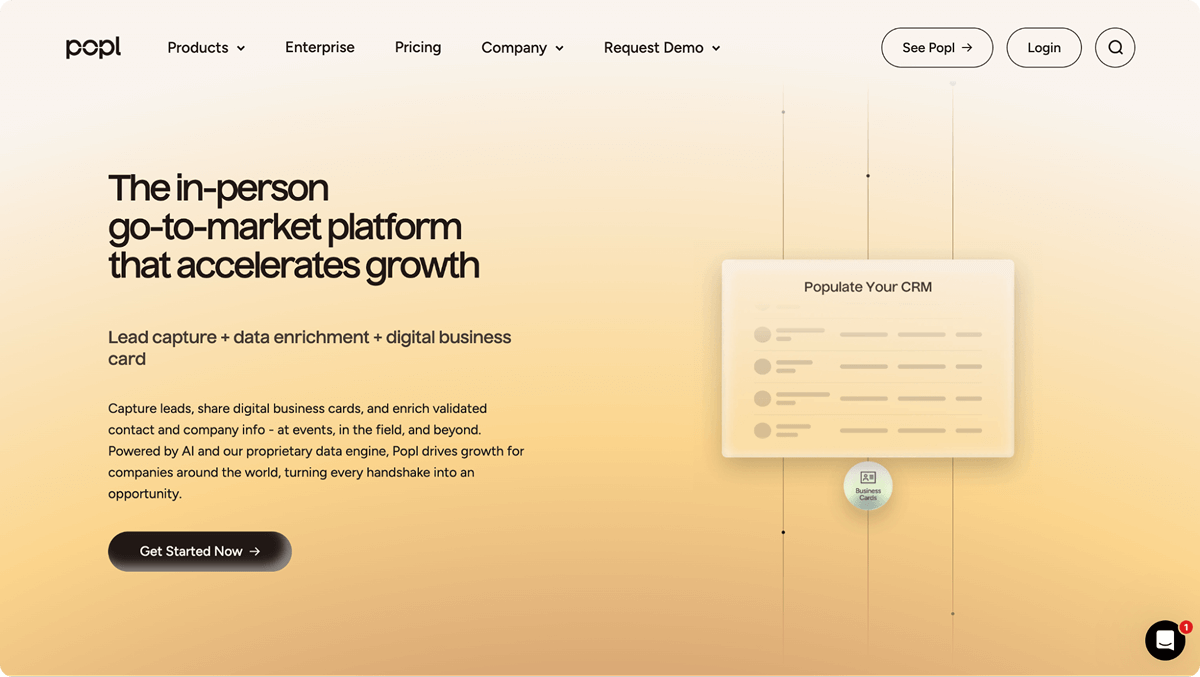
Popl took a very different path to the top. Founded in 2020, it began with NFC tap-to-share products that went viral on TikTok before evolving into one of the fastest-growing digital business card platforms worldwide. Today, it serves 2.5 million users in 150 countries, including many Fortune 500 companies.
Positioned as the world’s first “In-Person Go-To-Market Platform”, Popl’s mission is to connect companies with future customers by turning every meeting or handshake into a measurable opportunity. That focus has driven its transformation from a consumer gadget into an enterprise-ready platform with solid integrations, AI-powered lead capture, and scalable team management tools.
Backed by Y Combinator, Popl moves quickly and experiments often, blending human connection with smart automation. With ratings of 4.7/5 on Capterra and 4.6/5 on G2, it’s become a favorite among sales, marketing, and event teams that rely on in-person networking to drive results.
Key Features and Capabilities
Now that you know how Blinq and Popl differ in vision, it’s time to see how that plays out in practice. Both platforms promise to simplify networking, but their approaches vary—from design customization to contact sharing, data management, and analytics.
Below is a side-by-side look at how the two digital business card platforms stack up where it matters most.
Card creation and personalization
This is where the difference between Blinq and Popl becomes obvious.
Blinq puts design and brand control at the forefront. Its card editor feels polished and deliberate, offering a level of customization that suits companies with high design standards. Users can:
- Upload up to three images (a profile photo, company logo, and cover photo) and choose from several card layouts.
- Automatically detect and import company logos or upload custom versions.
- Adjust layout orientation for different devices, with options for horizontal and vertical arrangements.
- Customize background colors, typography, and font weight to maintain brand consistency.
- Add core business details—name, job title, company website, work email, and phone number—directly from the app or Blinq dashboard.
- Lock branding elements at the admin level to ensure all employee cards stay uniform.
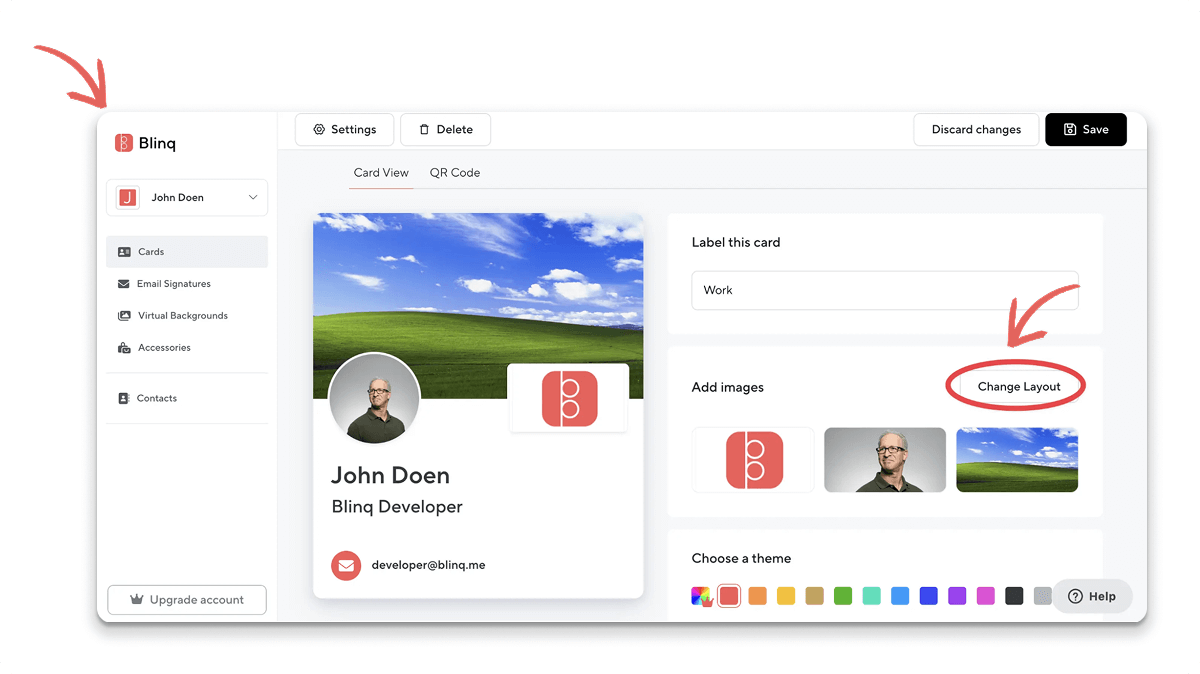
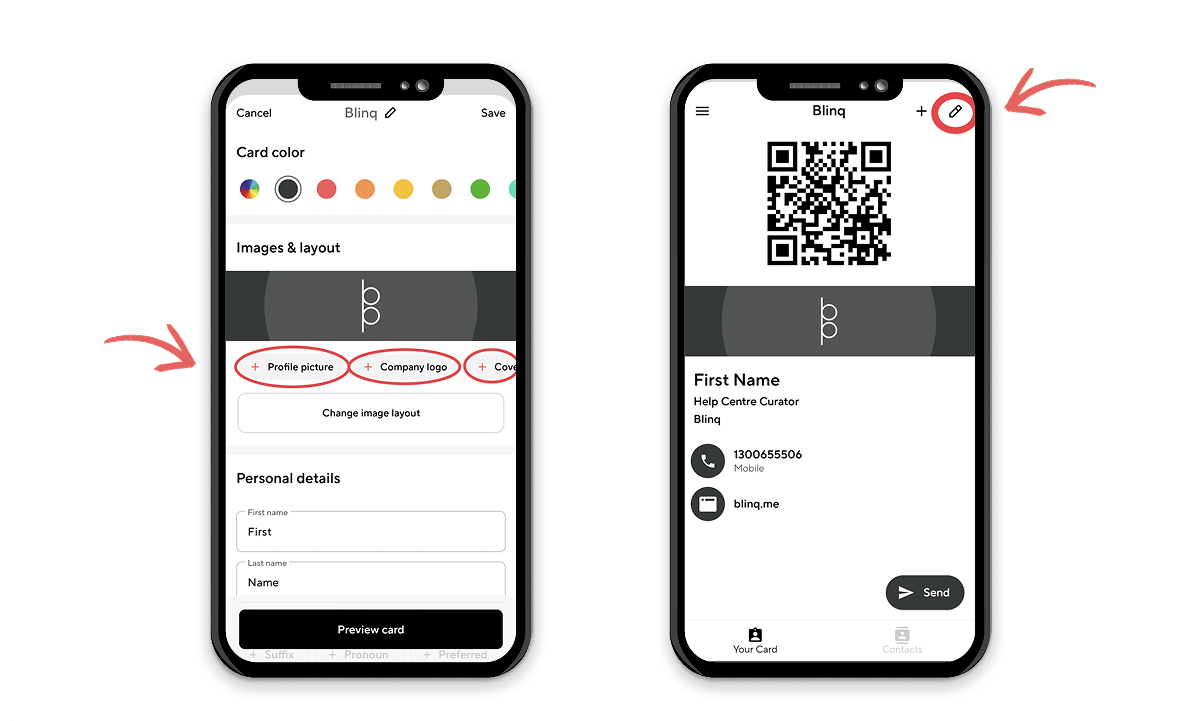
Popl, by contrast, is built for scalability and global reach. Its centralized admin dashboard simplifies template management for large teams. Users can:
- Create multi-language cards to support international teams.
- Choose from centered, left-aligned, or portrait layouts for desktop and mobile.
- Customize card themes, fonts, and link colors (with HEX code support).
- Add both common company links (e.g., website, careers page) and unique personal links (e.g., LinkedIn, Calendly).
- Embed a lead capture form or default follow-up email into each card template.
- Manage template permissions so only admins can assign or edit them.
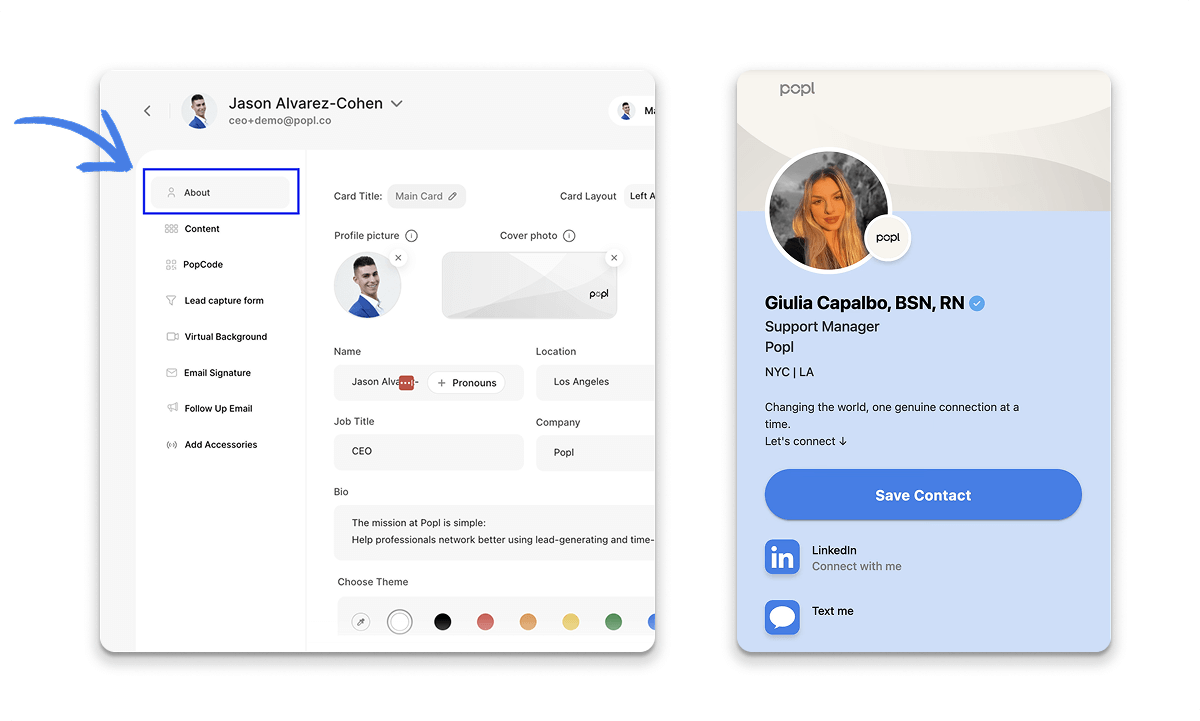
In short, Blinq wins on creative freedom and polish, while Popl stands out for efficient, large-scale rollout and centralized control.
Contact sharing methods (QR, NFC, links)
Both Blinq and Popl make in-person contact sharing effortless, offering the same essentials—QR codes, digital wallets, and physical NFC cards—but they take different approaches. Blinq focuses on accessibility and polish, while Popl emphasizes speed and omnichannel reach.
Blinq offers flexible sharing that fits any environment. Users can generate QR codes in the app or print them on a physical NFC card, much like Popl’s tap-enabled devices. Both integrate with Apple Wallet and Google Wallet for one-tap sharing.
What sets Blinq apart is its accessibility: every card opens directly in a browser—no app needed—and can be shared instantly via one-click email, text, or messenger apps. Users can also embed cards in email signatures, use short links, and add branded QR codes to virtual meeting backgrounds, making Blinq equally effective in-person or online.
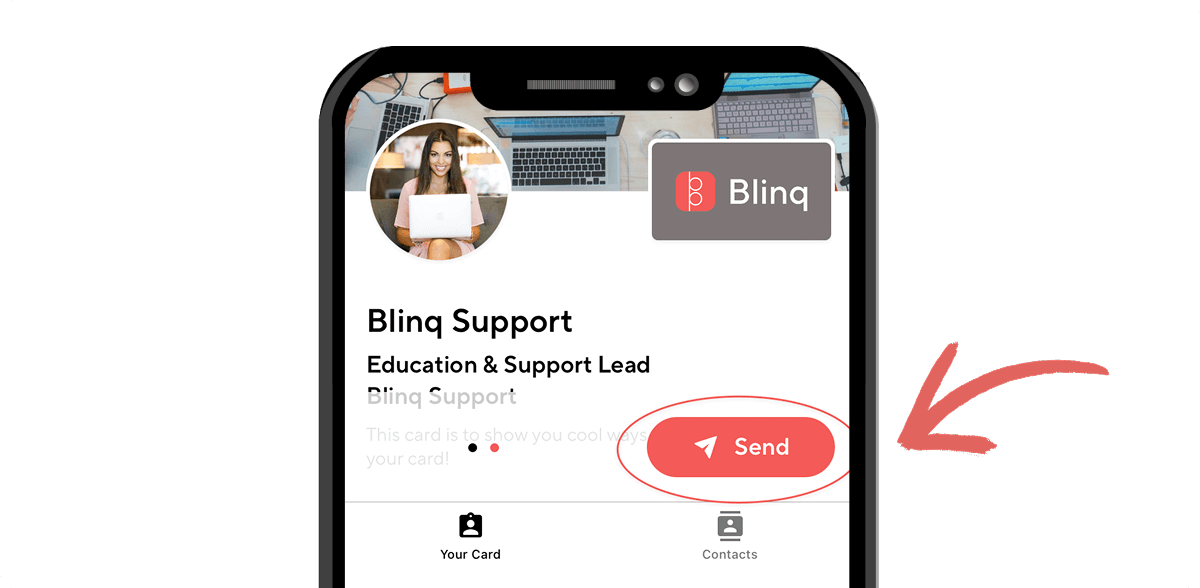
Popl, by contrast, expands sharing into a full omnichannel experience. Its physical NFC cards, badges, and lanyards enable instant tap-to-share at large events, while its digital options extend beyond face-to-face exchanges. Users can share via:
- Phone-to-phone tap or PopCodes (custom QR codes with logos and brand colors)
- Offline QR codes for low-connectivity environments
- Direct links like
- Text message and email for instant outreach
- Social platforms including LinkedIn, Instagram, X (formerly Twitter), and WhatsApp
- Apple Wallet and Google Wallet for mobile access
- QR codes pinned to the home screen or lock screen
- NameDrop for instant Apple-to-Apple contact sharing
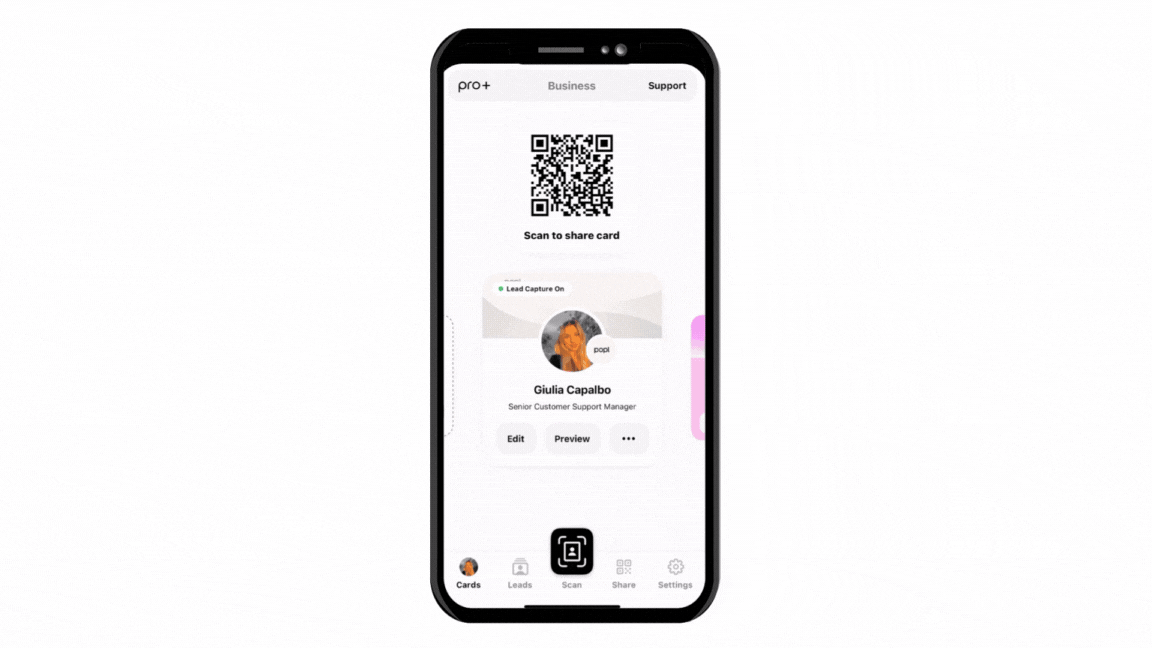
Contact management and lead capture
This is where the purposes of the two digital business card solutions clearly split.
Blinq focuses on relationship management. Each new contact is automatically saved with timestamps, notes, and tags, making it easy to recall context later. Contacts sync seamlessly with HubSpot, Salesforce, and Microsoft Dynamics, keeping records clean without manual updates. It’s built for professionals who value organized, meaningful connections over volume.
Popl, meanwhile, is built for lead generation. Its lead dashboard captures and enriches data instantly, syncing to connected CRMs with custom forms, lead assignments, and automated follow-ups. It even supports offline capture, ensuring no opportunity is missed.
In short, Blinq helps teams remember people; Popl helps teams convert them.
Analytics and insights
Both platforms help teams understand the impact of their networking activity, but their depth and intent differ.
Blinq offers straightforward visibility rather than complex reporting. Teams can see card shares, views, and engagement trends, giving a general sense of adoption and reach.
Popl, in contrast, turns measurement into a full-scale performance system. Its analytics are built to help sales and marketing teams quantify real-world outcomes. Popl allows users to:
- Track lead sources, engagement frequency, and ROI from every interaction
- Access event-level metrics that show which conferences or campaigns perform best
- Sync data directly with CRM platforms to connect in-person activity to revenue outcomes
- Visualize pipeline performance from first contact through conversion
- Measure individual and team productivity to identify top performers
Essentially, Blinq is good for teams that want surface-level insights, while Popl delivers advanced, data-driven intelligence that turns networking into measurable growth.
Unique tools in Blinq and Popl
Beyond their shared core capabilities, Blinq and Popl each offer distinctive tools that reflect their underlying philosophy. Blinq extends its focus on design, consistency, and brand control, while Popl leans into automation, analytics, and enterprise scalability.
Blinq stands out with:
- Dynamic email signatures automatically tied to each digital card, keeping every message on-brand
- Custom virtual backgrounds featuring embedded QR codes for seamless sharing during virtual meetings
- Apple Watch and home screen widgets for one-tap access in any setting
- A centralized admin dashboard for scalable team management and instant card updates
- SOC 2 Type II certification and GDPR compliance, ensuring enterprise-grade security
Popl differentiates itself with:
- A universal badge scanner that captures leads directly from event badges
- A paper card scanner to digitize traditional business cards
- Subteam management with independent CRM configurations and billing controls
- Automated follow-up emails and customizable reminders to streamline post-event outreach
- AI-powered enrichment that fills in missing contact or company data automatically
Ease of Use
For tools used in fast-moving environments—events, meetings, client introductions—ease of use determines how effectively teams adopt them. A digital business card platform should be fast to set up, simple to manage, and intuitive for both the sender and recipient.
Here’s how Blinq and Popl perform where it matters most.
Setup process and interface
Blinq keeps setup straightforward. Users can add their details, upload a profile image, company logo, and cover photo, then select a layout and color scheme.
Updates appear instantly, and admins can create or adjust multiple cards at once from a clean, minimal dashboard. It’s designed for teams that value visual consistency without extra complexity.
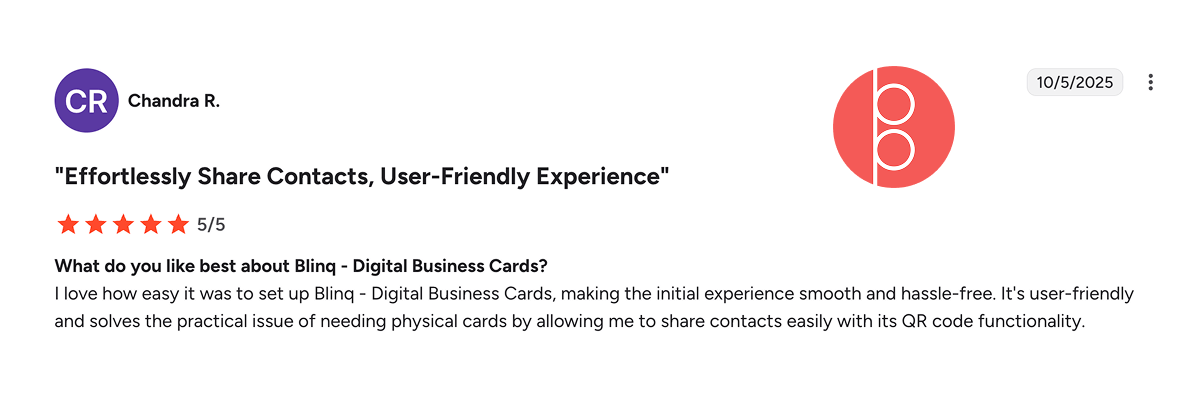
Popl streamlines setup for larger organizations. Its template system lets admins define layouts, colors, and permissions before rolling cards out company-wide. Individual users only need to fill in their unique links or details, cutting down setup time.
The interface is less visual than Blinq’s but optimized for scale and control.
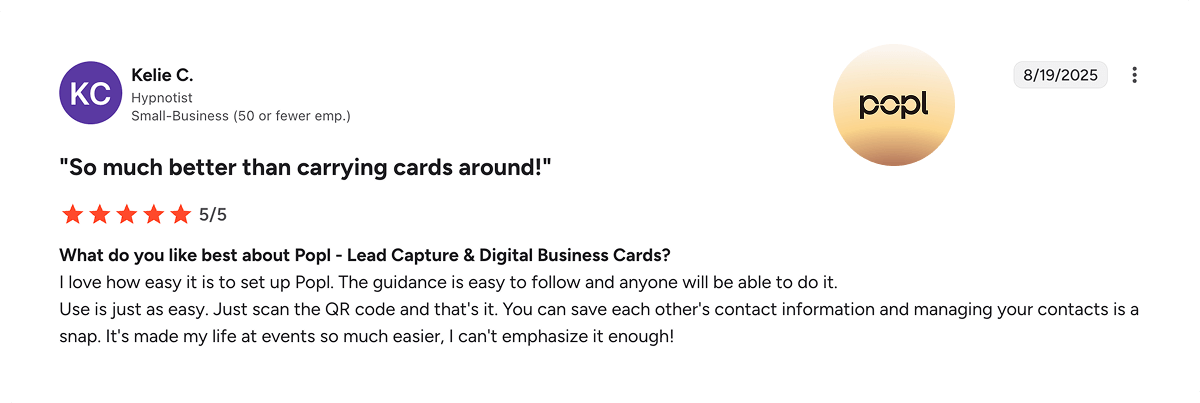
Mobile app experience: Popl vs Blinq
Blinq’s app mirrors its web dashboard—clean, visual, and easy to navigate. Editing cards, updating details, or sharing via QR code or link happens instantly. It’s intuitive and consistent, requiring little learning curve.
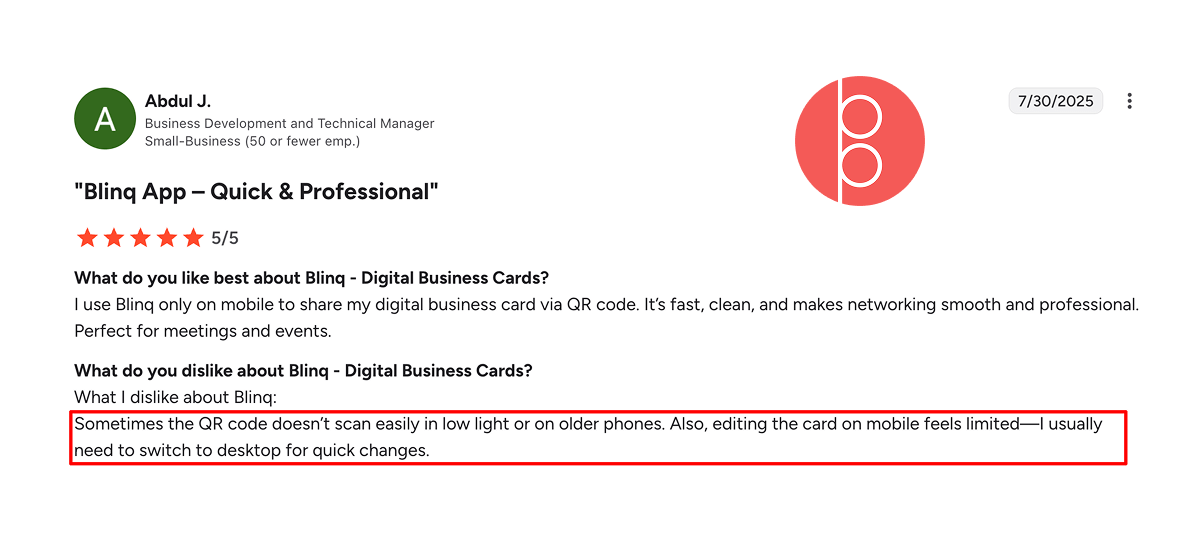
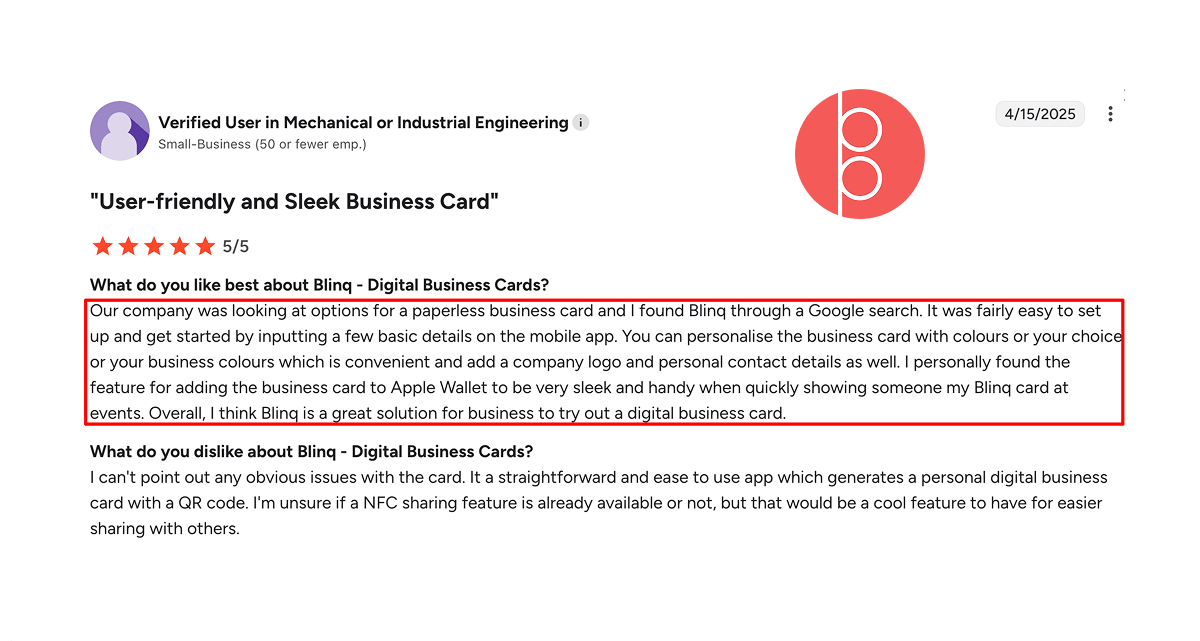
Popl’s app (#1 ranked mobile app for digital cards in App Store) focuses on speed and essential features. It’s a great companion for field use. Although, it’s only fair to note that some reviews online say more advanced features are only accessible via desktop version.
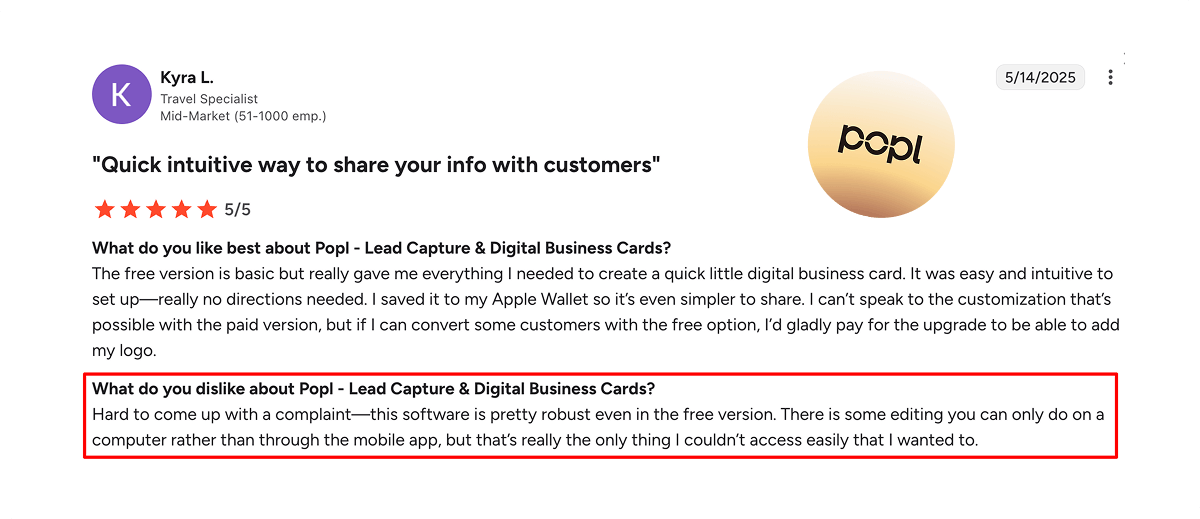
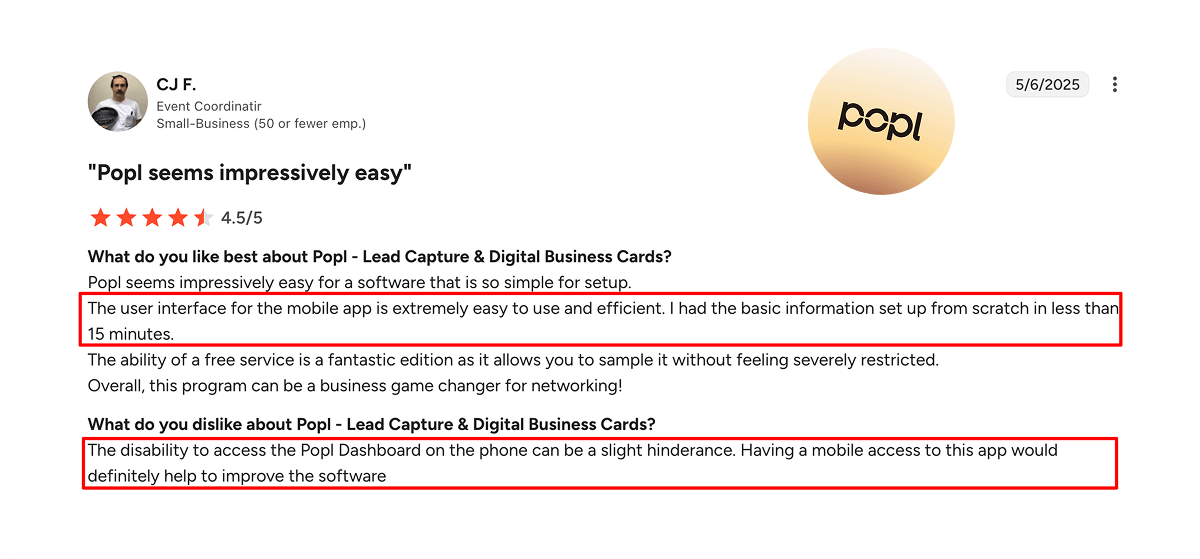
Recipient experience
One thing you can be certain about is that both platforms ensure a frictionless experience for the person receiving the card.
With Blinq, recipients access a branded, browser-based profile that opens instantly. They can save details or share their own contact info in a single tap, making exchanges quick and personal.
Popl offers a similar instant-view experience but includes more interactive options. Recipients can explore links, videos, and social profiles, and each interaction automatically feeds into Popl’s lead tracking system, giving teams visibility into follow-ups.
Blinq vs Popl Pricing
After covering usability, the next logical question is value—how much these tools cost and what you actually get for your money. Both Blinq and Popl follow a freemium model, but the structure, flexibility, and long-term scalability of their pricing plans differ in meaningful ways.
Free plans
Both platforms offer strong free tiers, but Blinq’s feels more practical for ongoing use.
- Blinq Free lets users create two digital cards, each with unlimited sharing, email signatures, virtual backgrounds, and Apple Wallet integration. It’s fully functional, giving individuals enough room to use it daily without upgrade pressure.
- Popl Free includes one digital card with access to its mobile app, email signatures, virtual backgrounds, and offline sharing. It’s best suited for testing the basics rather than managing multiple cards or detailed branding.
Paid subscriptions and packages
Blinq has clear, structured plans:
- Premium: from $7.33/month (annual) for individuals wanting custom branding, contact export, and branded QR codes.
- Business: from $4.99/month per user (annual, minimum 5 users) adds admin control, CRM integrations, and SSO.
- Enterprise: custom pricing for larger teams needing custom analytics, API access, and dedicated support.

Popl follows a similar tiered model:
- Pro: from $6.49/month (annual) unlocks contact capture and lead management.
- Pro+: from $11.99/month (annual) adds CRM sync, analytics, and brand customization.
- Teams: custom pricing for organizations, offering subteam management, permissions, and admin tools.
Interestingly enough, G2 reviewers feel like Popl could be cheaper, as 385 reviews mention it being “Expensive”, 256 talk about “Additional Costs”, and 232 cite “High Subscription Cost”. Many feel like “for those who want multiple business cards, the price tag can add up quickly”.
Value for money
Both platforms are competitively priced in the digital business card market. Blinq offers more functionality in its lower tiers and clearer scalability for SMBs, while Popl justifies its higher tiers with CRM automation, lead capture, and analytics built for sales performance.
Blinq delivers better value for teams prioritizing brand consistency and simplicity. Popl delivers stronger ROI for organizations focused on event networking and measurable growth.
Integrations and Compatibility
For growing teams, a digital business card platform needs to fit smoothly into existing systems. Let’s look at the integrations and compatibility for Blinq vs Popl.
Platforms and devices
Both platforms run on iOS, Android, and desktop browsers, syncing data across devices in real time. Blinq is fully functional on both mobile and web, making edits and sharing equally simple anywhere. Popl’s app handles essentials like sharing and lead capture, but advanced features—analytics, automation, and team management—are limited to the web dashboard.
CRM and business integrations
Blinq integrates natively with HubSpot, Salesforce, and Microsoft Dynamics, alongside Google Workspace for syncing email signatures and contacts. It’s geared toward corporate environments that prioritize brand consistency and workflow efficiency.
Popl offers broader connectivity through Zapier, supporting over 5,000 integrations. It also connects directly to Salesforce, HubSpot, and Outlook, enabling automatic lead sync, tagging, and CRM mapping. Its integrations are built for marketing and sales teams managing large pipelines.
Security and data privacy
Blinq emphasizes enterprise-grade compliance with SOC 2 Type II certification and GDPR readiness, appealing to organizations with strict data policies. Popl provides standard encryption and admin controls, though its focus lies more on functionality than audit-level compliance.
Both tools handle user data responsibly, but Blinq positions itself as the safer choice for companies with formal security requirements.
Customer Support and Reliability
When teams depend on a digital business card system every day, strong support and consistent reliability matter as much as features. Both Blinq and Popl maintain responsive service, but their support structures and reputations differ.
Blinq vs Popl support options
Blinq offers 24/7 email and chat support across all plans, with priority assistance and dedicated account managers available to Business and Enterprise users. Its setup guides and help center are detailed, helping teams resolve most issues independently.
Popl provides email and chat-based support during business hours, with additional onboarding help for team accounts. Larger clients receive personalized support through assigned customer success representatives.
While dependable, Popl’s assistance is less continuous than Blinq’s round-the-clock availability.
Reputation and user reviews
User sentiment clearly favors Blinq. Across review platforms, it holds a higher average satisfaction score and more consistent feedback:


Company reliability
Both companies are well-established and continue to grow. Blinq, backed by major investors including HubSpot Ventures, has expanded to over 500,000 businesses worldwide with infrastructure built for enterprise uptime. Popl, funded by Y Combinator, also serves millions globally, with a proven record supporting large-scale events and corporate teams.
In practice, Blinq is regarded as steadier for long-term organizational use, while Popl excels in fast-paced, event-driven environments where rapid deployment matters most.
Pros and Cons
Every digital business card platform comes with trade-offs. Now that you know everything there is to know about Blinq and Popl in terms of their core features, pricing, and reputation, it’s time to clearly weigh the strengths and weaknesses of the two.
Pros and cons of Blinq
| Pros of Blinq | Cons of Blinq |
| Exceptionally intuitive setup and interface | Fewer automation tools compared to Popl |
| High design polish and brand consistency across teams | Limited analytics depth for enterprise sales tracking |
| Strong free plan with two digital cards | Less hardware variety (only standard physical NFC cards) |
| Seamless CRM integrations with HubSpot, Salesforce, and Microsoft Dynamics | Advanced integrations require Business or Enterprise plans |
| Browser-based sharing—no app needed for recipients | Limited customization for lead capture forms |
| 24/7 customer support and strong reliability record | Slightly higher cost per user for large teams needing admin controls |
| SOC 2 Type II and GDPR compliant, suitable for regulated industries | Focused more on branding than sales performance |
Pros and cons of Popl
| Pros of Popl | Cons of Popl |
| Industry leader in tap-to-share and NFC devices | Some advanced features available only on the web dashboard |
| Excellent CRM and workflow integrations via Zapier (5,000+) | Interface less refined than Blinq’s design-led layout |
| Robust lead capture, enrichment, and automation tools | Lacks 24/7 customer support coverage |
| Wide range of physical NFC products (cards, badges, keychains) | Free plan limited to one digital card |
| Strong analytics with ROI and event-level insights | Higher-tier plans required for full branding control |
| Ideal for sales, marketing, and event-driven teams | Less emphasis on design customization |
| Backed by Y Combinator, trusted by global enterprises | Not as compliance-focused as Blinq (no SOC 2 certification) |
Blinq vs Popl: Which One is Better in 2025?
Both Blinq and Popl stand out as leading digital business card platforms in 2025, each built around a different philosophy.
Blinq focuses on brand consistency, simplicity, and security. Its clean design, dependable app, and enterprise compliance make it a strong fit for teams that value professionalism and centralized control—especially in larger or regulated organizations.
Popl is optimized for scale and measurable growth. With event-ready NFC tools, advanced analytics, and lead capture automation, it suits sales and marketing teams that see in-person networking as a core revenue driver.
In short:
- Choose Blinq for refined branding, ease of use, and enterprise reliability
- Choose Popl for lead generation, data-driven insights, and event-scale performance
Both are proven industry leaders—the better fit depends on whether your team values presentation or performance.
Beyond Blinq and Popl: The Digital Business Card Reinvented by MySignature
While Blinq and Popl dominate the digital business card conversation, they’re not the only options—and they’re far from perfect. Blinq can feel rigid when teams want deeper marketing functionality. Popl, meanwhile, leans so heavily into automation that smaller teams often pay for features they’ll never use.
If you’re looking for something that bridges branding, communication, and contact management without overcomplicating the process, MySignature is worth serious attention.
MySignature combines digital business cards, professional email signatures, and link-in-bio pages in one streamlined platform. For as little as $6 per member/month (for individual users) or $2.4 per member/month (for teams over 5 people), you get a unified hub for building your brand presence and managing outreach—all under one login.
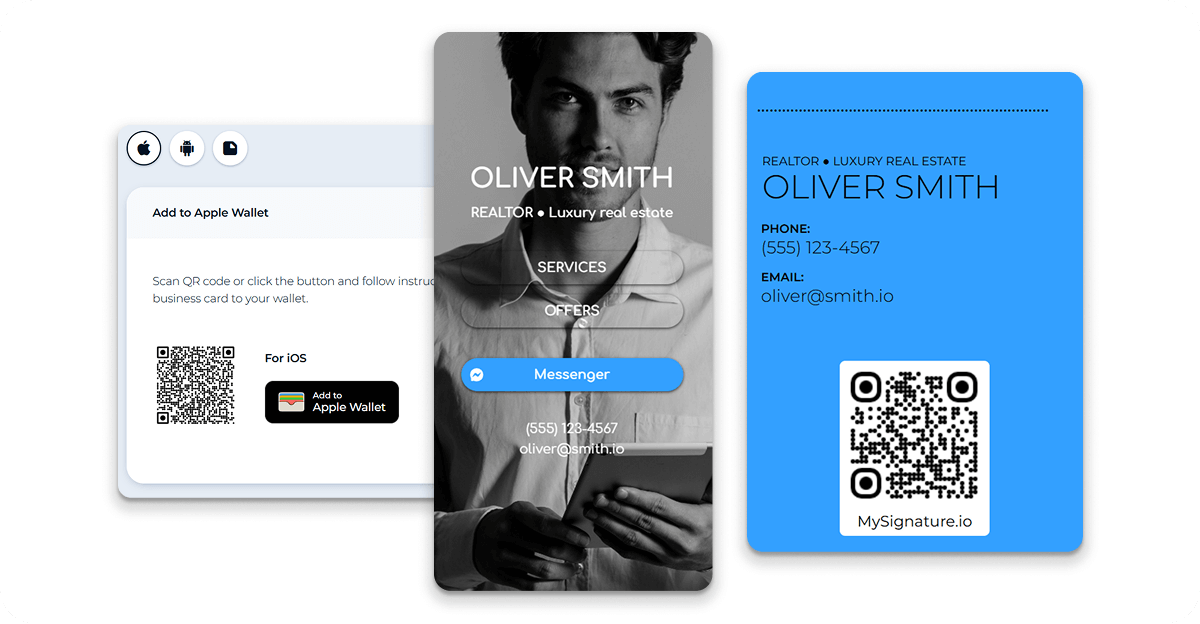
With MySignature’s Digital Business Card, you can:
- Create and share cards via QR code, NFC, or link in seconds
- Keep contact details, links, and social profiles instantly up to date
- Manage everything through Google Workspace or Microsoft 365 integration
- Control branding and deployment from a centralized admin dashboard
- Pair cards with custom email signatures and promotional banners for a full brand ecosystem
MySignature isn’t just another business card tool—it’s a complete communication suite built for teams that want simplicity, automation, and consistent branding without paying enterprise prices.
If Blinq perfects design and Popl optimizes performance, MySignature unifies both—and does it at a fraction of the cost. Try MySignature Digital Business Card now!
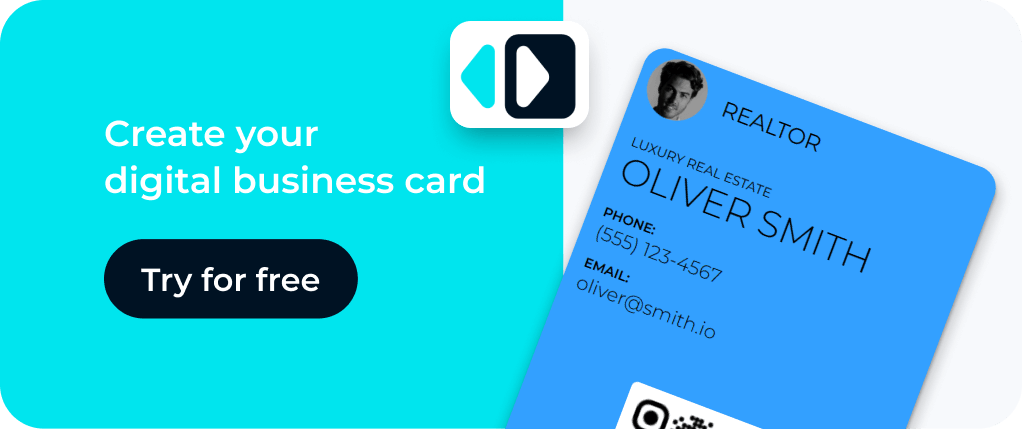
FAQ
What makes Blinq different from Popl?
Blinq focuses on branding and usability, giving teams full control over design consistency and data security. Popl prioritizes lead capture and analytics, offering deeper integrations for sales and event-driven workflows. Blinq suits structured organizations; Popl suits teams chasing measurable growth.
Do recipients need an app to save contacts?
No. Both Blinq and Popl allow recipients to open your card in a browser and save details instantly—no app download required.
Which platform has the better free plan?
Blinq’s free plan is more generous, offering two customizable cards, widgets, and branded email signatures. Popl’s free version limits you to one card and fewer customization options.
Do Blinq and Popl integrate with CRM tools?
Yes. Blinq connects with HubSpot, Salesforce, and Microsoft Dynamics. Popl offers broader CRM access via direct integrations and Zapier, supporting over 5,000 apps and automations.
Can I update my digital card after sharing?
Absolutely. Both platforms update contact information in real time. Anyone who has your card will always see your latest details—no need to resend or re-share.


